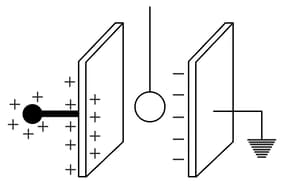Two identical conducting spheres are charged by induction and then separated by a large distance. Sphere has charge and sphere has charge . A third sphere is initially uncharged. If sphere is touched with sphere and separated and then touched with sphere and separated again, what is the final charge on each of the three spheres?
Important Questions on Coulomb's Law and Electric Field

Figure show two charged particles on an axis. The charges are free to move. At one point, however, a third charged particle can be placed such that all three particles are in equilibrium.
(a) Is that point to the left of the first two particles, to their right or between them?
(b) Should the third particle be positively or negatively charged?
(c) Is the equilibrium stable or unstable?

Two small balls having equal positive charge (coulomb) on each are suspended by two insulating strings of equal length (meter) from a hook fixed to a stand. The whole setup is taken in a satellite to space where there is no gravity (state of weightlessness).
(a) What is the angle between the two strings?
(b) What is the tension in each string?
Suppose we have a large number of identical particles, very small in size. Any two of them at separation repel with a force of .
(a) If one of them is at from a group (of very small size) of others, how strongly do you expect it to be repelled?
(b) Suppose you measure the repulsion and find it as , how many particles are there in the group?
